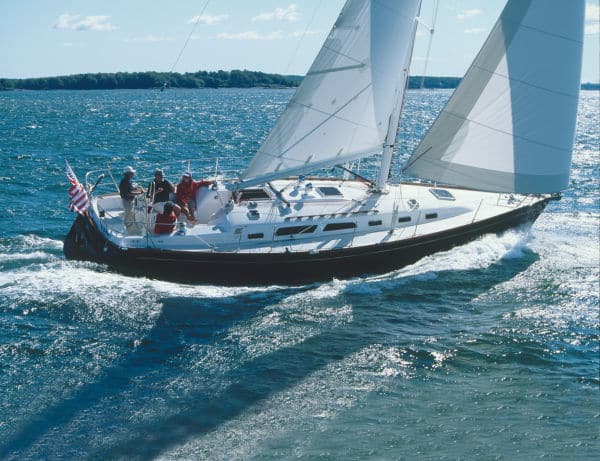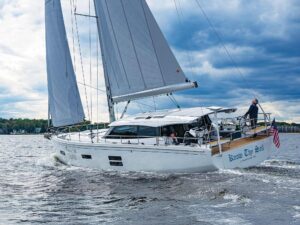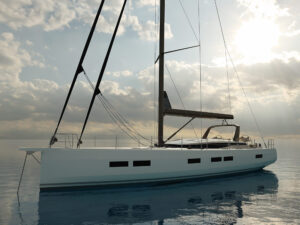
With a gusty but light northwesterly and a tide ebbing at full bubble out of Rhode Island’s Narragansett Bay, the Sabre 426 had her work cut out for her scratching to windward. True to Sabre reputation, the 426 bore down with alacrity on our windward mark, a lobster-trap buoy tugging against the current.
There was no finish line, just us, the wind, and the current. After a quick tack around the buoy, the Atlantic lay before us, and the Caribbean seemed eminently doable—just a hop, skip, and a jump away. Elegantly walking the line between speed and comfort, the Sabre 426 brings either fantasy well within reach.
This is the third boat in the 42-foot range to emerge from Sabre, the Maine-based builder that in 32 years in the business has earned respect for producing solid, eye-catching boats with wide allure, quality workmanship, and enduring value. Sabre’s focus on this size is no wonder. Forty-two feet is the Goldilocks number, striking a happy medium between being big enough to carry a crew and payload to far horizons and small enough to be easily managed by a shorthanded crew. For a couple or small family, 42 feet is, so to speak, just right. And with 13 feet of beam (allowing for a commodious double cabin aft and ample storage), two couples could be quite content island-hopping, passagemaking, or exploring for weeks on end.
The 426 is the latest product of Sabre’s collaboration with Jim Taylor Yacht Design, a winning combination that’s yielded a stable of thoroughbreds: the 1994 Sabre 36, the 1997 Sabre 402, and the 1999 Sabre 452. Among this year’s fleet of new models in our Boat of the Year contest, the Sabre 426 stood out in a category of luxury midsize boats as the most exciting performer.
The 426 was one of several boats we sailed twice, once when I joined Parker Harrison of New Wave Yachts for a light-air romp on hull number one in Narragansett Bay in September and again when the BOTY judges sailed hull number two in gusty, 10- to 15-knot winds on the Chesapeake in October. Both took the shoal-draft option with a 5-foot draft and 8,650 pounds of ballast, concentrated in a bulb and two tapered winglets at the base of the keel. In my view, the shoal draft’s adeptness in thin water more than compensates for any trade-off in windward performance. The wing keel provided ample lift as we easily tacked through 90 degrees. A cruiser who likes to race would do better with the 6-foot-10-inch keel, which carries 250 pounds less in ballast; ultimately, the choice will hinge upon where and how you intend to sail.
Taken together, the 426’s numbers neatly demonstrate Sabre’s design brief: a moderate-displacement cruiser that delivers performance without sacrificing the ability to carry a cruising payload. Reflecting the weight savings of the Divinycell-cored hull, the boat’s sail area/displacement ratio of 17.7 and displacement/length ratio of 230 put it on the performance edge of the cruising spectrum, with enough canvas to skate through the lighter stuff and generate a real rush when the wind pipes up.
Refined Lines
Unmoved by the current design trend toward multilevel cabins, Sabre has stuck with its satisfyingly sleek look, with just a slight rise forward in the 426’s sheer line. Matching this are a fine bow with little overhang, a bow knuckle, and a wide run aft. In fair proportion, the beam widens out just forward of amidship, then carries well aft. The canoe underbody has enough deadrise forward to mitigate pounding. No sharp angles distort the coachroof, which is accented by two large fixed portlights and four opening ports on each side. Both versions we sailed featured an integral swim platform aft; a traditional stern is an option.
The three-spreader, 59-foot mast is supported by Navtec rod rigging and stepped slightly forward. This setup opens up sky above the cockpit, reduces the J dimension, and makes for a big, but manageable, high-aspect mainsail. It also allows for fine control when sailing under mainsail alone. The size-44 Lewmar electric winch on the starboard cabin top to serve the main halyard is a big help. The Sabre’s midboom mainsheet is led through a rope clutch to a winch at the cabin top shared by the halyard, topping lift, and reefing line. For the mainsheet, I’d prefer a dedicated cleat and winch, preferably closer to the helmsman.
The boat I sailed had a 130-percent genoa, which to windward provided sufficient power to hit 6 knots in about 8 knots of true wind on Narragansett Bay. The cap, intermediate, and lower shrouds are fixed to a single, multitang chainplate inboard on deck. Besides minimizing the chance of leaks through the deck, this leaves ample room between the shrouds and lifelines to move fore and aft, allows the rig to be tuned without sending a crewmember aloft, and permits narrow sheeting angles.
The standard engine is a 55-horsepower Westerbeke 55A, but the boat I sailed had the optional 56-horsepower Yanmar HJ3E. Sabre also offers the new, slower-turning Westerbeke 55B, which would provide higher torque in the lower rpm range and is smaller and lighter than the 55A. Any of the three should offer good fuel economy at about 6 knots and plenty of reserve power. The galley limits access to the engine’s port side, although Sabre’s installation ensures that this is no obstacle to routine maintenance.
The 426 is Sabre’s first model whose hull is vacuum-bagged, a technique that provides immense clamping loads to ensure a bulletproof core-to-skin bond.
The yard has also shifted from balsa core to lighter Divinycell foam in both the hull and deck, affording not only a favorable strength-to-weight ratio but also good insulating properties. The inward-turning hull/deck joint is through-bolted and bonded with 3M 5200 and capped with an integral teak toerail. Bulkheads, berth faces, shelves, and beefy floor stringers are laminated to the hull to provide superior structural reinforcement. All seacocks are Marelon and installed through glassed-in riser pads for strength. The high-aspect spade rudder is fitted to a heavy-duty carbon-fiber rudderstock.
Buttoned down, the boat should have little trouble keeping water where it belongs. The opening ports (Whitewater Marine) and hatches (Lewmar) were well bedded and well fastened, and a 10-inch-high bridgedeck provides a desirable barrier against boarding seas. The cockpit has two 1.5-inch- diameter drains; one BOTY judge suggested increasing the number or diameter of these drains to more quickly empty the spacious cockpit.
On deck, the 426 is ably fitted out for bluewater duty. Formidable chainplates, stanchions, and deck hardware are well bedded and through-bolted with backing plates. The heavy-duty twin bow roller says cruising boat. Chain and rode reside in a self-draining forepeak locker that’s split into two sections. A watertight bulkhead separates this from the V-berth. Six hefty 10-inch cleats are well placed to handle bow lines, springs, and stern lines.
A Peek Below
The 426’s light, cherry interior, highlighted by ash ceiling and inlays at the companionway, offers a comfortable refuge in a blow. The joinery reflects quality craftsmanship, and the layout blends several attractive features. All lockers are finely fitted with doors that latch securely and leave plenty of room for ventilation and expansion. Courtesy lights at the base of the companionway steps and along the sole at the through-passage to the main saloon provide a measure of safety that won’t spoil night vision. I was most impressed by the U-shaped galley to starboard, with Corian countertops, easily accessible lockers, and a handy self-draining, top-loading drying rack for dishes next to the sink. The well-gasketed and insulated fridge allows access through the top or side—no blind digging in the cold. A small hatch and opening port over the gimballed stove are sure to please the cook in warmer climates.
Opposite the galley, the forward-facing nav station provides ample room for charts, handy nooks for tools, books, and cruising guides, and plenty of vertical space to mount a chart plotter and radar display. Aft of the nav station is a comfortable double berth with a hatch that opens under the port cockpit seat, providing good ventilation in a space that often lacks it. The cabin also featured a small vanity sink, a nice touch for when guests are aboard. A bundling board would make this a suitable sea berth under way.
The lightweight, core-laminate dining table in the main saloon folds up against the bulkhead to yield enough floor space for a tight tango between the L-shaped settees on either side. This makes a great gathering place when a cold front chases the party below or the intertropical convergence zone drifts over your lagoon. The table, which is hinged in the middle, can seat anywhere from four to eight. When fitted with lee cloths, either settee can serve as a 6-foot-5-inch sea berth, and the port settee converts to a double berth.
To port and forward of the main cabin is an ample head with a shower; opposite this is a cedar-lined hanging locker. The head is separated by a pocket door, which frees up a good deal of space that a swinging door would require. A bifold door seals off the shower; a simple shower curtain with battens would do just fine by me and would simplify cleaning.
The comfortable V-berth has ample storage and a small settee, and it’s well ventilated.
Overall, the 426’s systems adhered to—or improved upon—both the American Boat & Yacht Council (ABYC) and Coast Guard standards, reflecting Sabre’s long experience building boats meant for the real world. At every turn, Skip Moyer, who recently retired as president of the ABYC, found details he liked. A few minor points came up: although the Sabre’s American Wire Gage size-6 wire from the chainplates to ground meets the ABYC’s minimum recommendations for lightning protection, AWG 4 is preferable here; the manual cockpit bilge is too small to move water quickly in an emergency (a trait common to nearly every boat we looked at); and the discharge hose for the 1,000-gallons-per-hour electric bilge pump had a 90-degree elbow and a check valve right at the pump, immediately chopping the flow rate. In general, check valves are to be avoided in this hose run, but if required, they should be easily disassembled or bypassed.
The new owner should also consider, in advance, a block-and-line arrangement to provide more leverage for the short emergency tiller. But these are relatively minor glitches, easy fixes in what’s an otherwise superb systems execution.
By noon, the wind on Narragansett Bay was coming in cool blasts from the north. With each one, the Sabre accelerated quickly. On a beam reach, I sat on the leeward rail with just a finger on a helm. It’s rare to find a boat that handles so sweetly yet can carry you so far. But then again, this was a Sabre, so I wasn’t too surprised.








